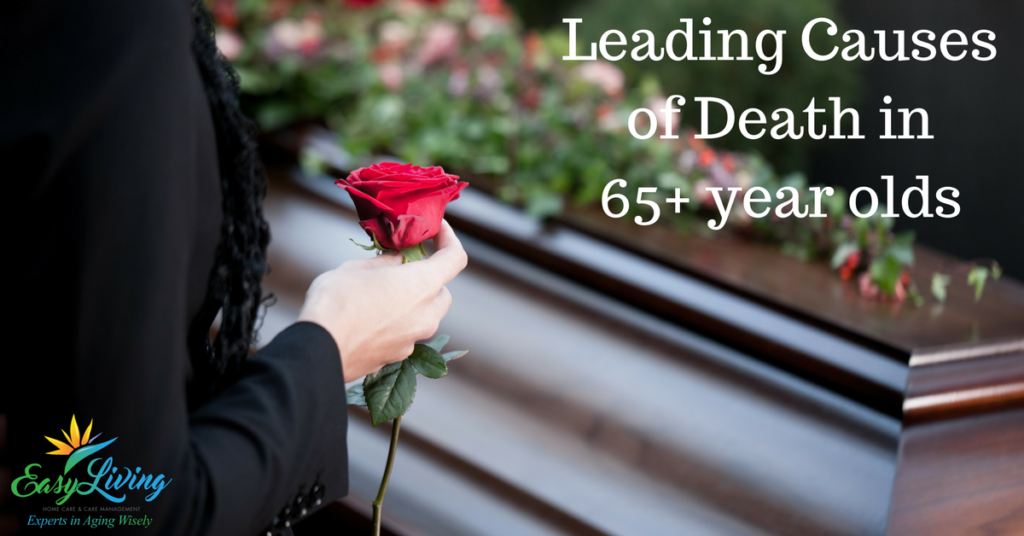Do you know the leading causes of death for older adults in the U.S.? And, why should it matter to you?
Interestingly, the list has changed a fair amount since 1980. We’ll share the (perhaps surprising) top causes of death and the lessons in these stats. Our team will provide some wellness and lifestyle tips to avoid these sometimes preventable deaths.
#1: Heart Disease
The top cause of death has not changed. However, more women are now dying of heart disease. Also, there’s been an overall (slight) reduction in heart disease death. This likely points to increased preventative care, as well as advancements in medications and procedures.
What can you do?
To control the risks of heart disease, you should get regular preventative screenings. Medicare covers a number of key cardiovascular screenings as well as overall wellness services. Such services have contributed to the reduction in heart disease deaths, yet many seniors still don’t fully take advantage of them.
The CDC reports that 80% of heart disease deaths are attributable to lifestyle factors. Thus, changes in diet, activity, health management, etc. could prevent many deaths. It can be especially hard for older adults to implement lifestyle changes. So, it may be helpful to have some support in doing so.
Elders at risk of heart disease need to monitor vital signs at home, in addition to keeping up with regular medical appointments.
What can we do?
Design and implement a health plan, support and monitor health signs at home, manage medical appointments
#2: Cancer
While cancer’s retained the same place on the list, the actual numbers have increased significantly. As people live longer, this may be somewhat inevitable (and can also be a good sign that people are living longer after a cancer diagnosis). It also means that many elders are struggling through cancer and the sometimes difficult treatments.
As with heart disease, lifestyle factors play a role in many cancers. It’s never too late to make a difference, even after you’ve been diagnosed. Eat a healthy diet, increase physical activity, quit smoking and reduce alcohol intake.
How can we help?
- Support during cancer treatment: driving you to appointments, taking care of you when suffering from side effects, monitoring reactions and contacting your health professionals, ensuring safety when you’re weak, providing hydration and nutritious food that’s easy on your stomach
- Medication management (especially important with complex/new routines)
- Patient advocacy: helping you find the best providers, researching treatment options, attending appointments, helping prepare questions and summaries for medical visits, communicating with family members, etc.
#3: Chronic Lower Respiratory Diseases
This cause is newly ranked at number three, though it may be partly due to measurement changes. However, this may be one of the most surprising leading causes of death. While most of us immediately think of heart attacks, cancer and stroke, very few people realize how common Chronic Obstructive Pulmonary Disease (COPD) is.
COPD is often related to smoking or environmental causes. It tends to be a chronic illness that can be managed with various therapies. This may include medications, inhalers, steroids, oxygen therapy, pulmonary rehabilitation and, more rarely, surgery. Additionally, patients with COPD must carefully manage exacerbations and respiratory infections. This is where the condition can turn from chronic to fatal.
Managing Chronic Respiratory Disease to Avoid Unnecessary Crises and Death
Respiratory disease patients need excellent health monitoring and care. A trained caregiver in the home can track symptoms, ensure medications/treatments are taken properly, and support overall health.
Pulmonary rehab. often involves exercise training, which strengthens the lungs and boosts immunity. Lack of activity is a breeding ground for pneumonia and infections that are often killers for elders.
Our EasyLiving care plan is designed to keep you healthy by supporting your exercise plan, treatment schedule and more. Respiratory patients can particularly benefit from being supported at home, where they may be less exposed to infections
#4 Cerebrovascular Disease
Make sure you’re aware of the signs of stroke (plus get other great tips). Quick intervention and improved treatment likely accounts for this cause of death declining.
As with many of the other conditions, prevention and health maintenance will reduce your risks. Make sure you have a customized health plan and the support you need to carry it out. For people who have already had a stroke, rehabilitation, quality aftercare, and future prevention are a must.
#5 Alzheimer’s Disease
This is a big surprise on this list…one of the only causes of death that didn’t even make the top 10 in 1980. One of the biggest “risk factors” in Alzheimer’s disease is age so this makes sense for an aging population. It also means that aging and eldercare have changed drastically. The impact of Alzheimer’s disease on families and society cannot be overstated.
Brain Health and Memory Care
Cultivate a healthy brain. Stay active (physically and mentally). Be engaged (volunteer, stay social, keep up favorite activities). Eat a heart-healthy (i.e. brain-healthy) diet. Let EasyLiving build a care plan designed to keep your brain and body at its best.
For elders with Alzheimer’s or cognitive issues, quality memory care is essential. The best memory care is provided in the comfort of home, maintaining a familiar routine. Quality home care by dementia-trained specialists provides safety and security. It can reduce the chances for accidents like falls, fires, and car wrecks. Additionally, top notch in-home care prevents crises and unnecessary decline. Most importantly, it helps the patient AND family.
Additional Causes of Death That Might Surprise You
Diabetes and unintentional injuries have moved up to the #6 and 7 causes of death.
Diabetes Management
Elders with diabetes are prone to all kinds of potentially fatal health issues. Circulation and the immune system become compromised. It’s essential for anyone with diabetes to monitor these concerns along with blood sugar levels and key vital signs.
Even minor injuries can become fatal for a diabetic and they may go unnoticed due to circulation problems and nerve damage. Thus, home safety is of utmost importance. Of course, the diabetic person also needs good nutritional support and proper medication management.
Injuries
Falls make up 55% of fatal injury deaths. Most falls could be prevented. Click Here for our Falls Prevention/Safety Checklist. And, contact us TODAY for a personal home safety assessment.
Motor vehicle accidents are the second biggest category. Are you worried about a loved one’s driving? If you’ve had doubts, there’s likely a problem. And, if you respond with “Mom only drives during the day” or “Dad stays nearby”, it’s time to assess further. You don’t want the fatal accident (for them or someone else) to be when you find out the limitations weren’t enough. The end of driving doesn’t have to mean the end of a good life.







